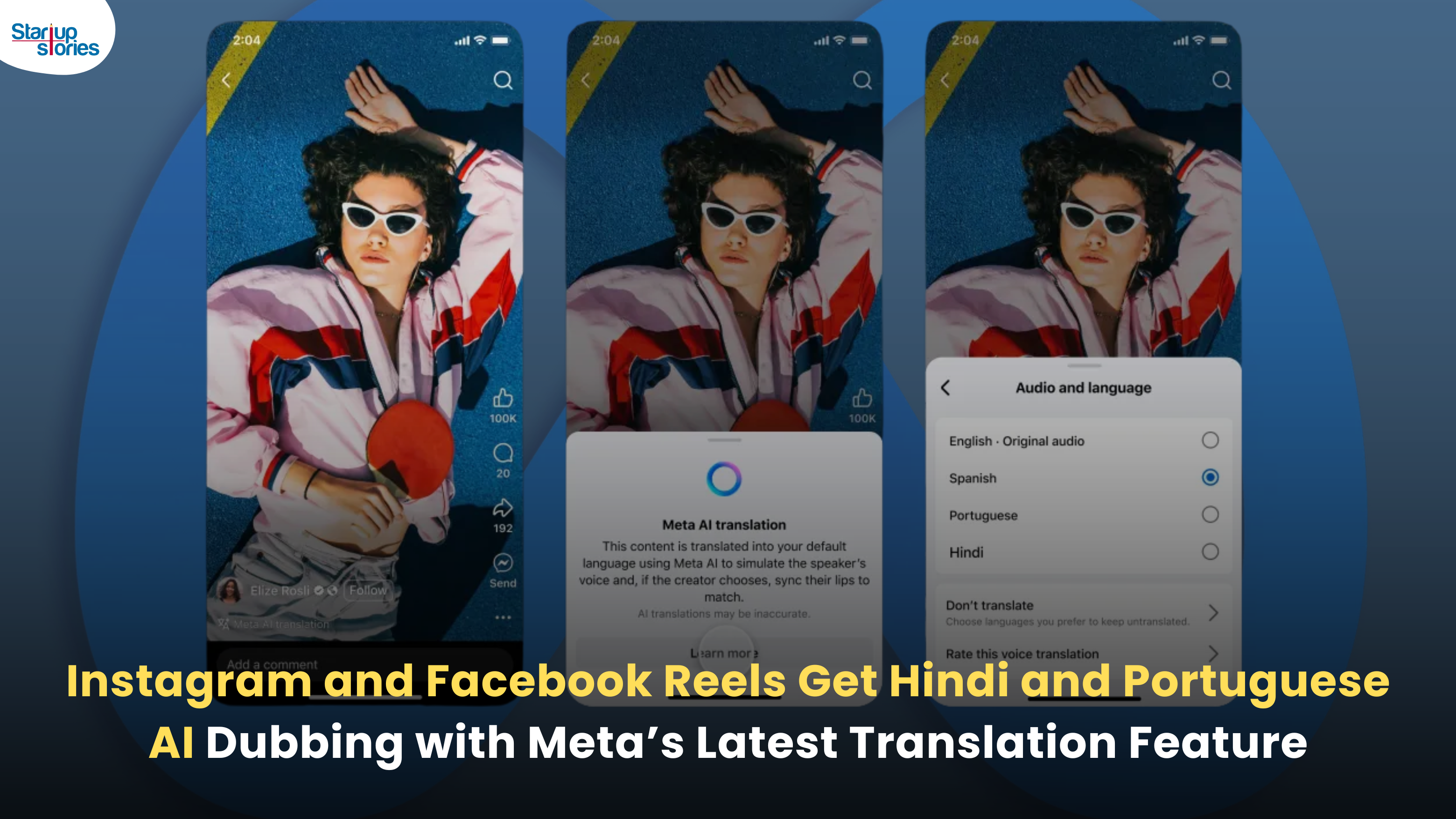Latest News
Amazon’s AI Shopping Assistant ‘Rufus’ Launches in India!

Online shopping more accessible than ever, platforms like Amazon offer consumers countless choices, but navigating these options can be overwhelming. To streamline the shopping journey, Amazon has introduced an AI-powered chatbot named Rufus. Currently in beta, Rufus is available to select Android and iOS users in India.
What is Amazon Moments?
Amazon Moments is designed to help users relive iconic moments from their favorite shows and movies by allowing them to save and share clips within the app. With movie and TV show scenes frequently shared on social media, Moments puts Netflix in the game by letting users highlight and circulate memorable content directly through the platform.
In a statement to Variety, Netflix actor Giancarlo Esposito expressed his enthusiasm for Moments, saying, “I know firsthand there’s something magical that happens when a powerful story finds its audience on Netflix. Suddenly everyone is captivated and can’t stop talking about it, and that passion just keeps compounding.” Netflix hinted that this is just the beginning for Moments, with “more features” planned to enhance the sharing experience.
How Does Rufus Work?
According to Amazon, Rufus can be accessed while using the mobile app. The new Rufus icon will appear in the lower right corner of the screen. Users can click on this icon to open a chat window where they can ask questions related to shopping needs, products, and comparisons. For example, users can inquire about specific products by asking questions like “What should I consider when buying a washing machine?” or “Should I choose a fitness band over a smartwatch?” Rufus will provide tailored recommendations based on user preferences.
User Experience
Creating a seamless shopping experience, Rufus allows customers to interact naturally with the app. Users can ask broad questions or seek specific product comparisons. For instance, if looking for a smartphone, Rufus can help filter options based on criteria like battery life, display size, and storage capacity.
Enhancing E-Commerce Engagement
With Rufus, Amazon aims to enhance viewer engagement and provide a more interactive way for fans to connect with the content they love. This new feature aligns with Amazon’s ongoing mission to make the shopping experience more social and accessible.
Limitations and Future Improvements
While Rufus performs well in many instances, there are some limitations. For example, when queried about WearOS smartwatches with high battery life, it recommended the OnePlus Watch, which was close but not the optimal choice. In other cases, it suggested discontinued models like the Asus Zenfone 9 when asked about smartphones with high battery life.
Despite these inaccuracies, Amazon encourages user feedback to improve Rufus over time. Customers can rate responses with thumbs up or down and provide additional comments to help refine the AI’s recommendations.
Competitive Landscape
Rufus’s introduction comes as other e-commerce platforms also enhance their AI capabilities. For instance, Flipkart has launched its own AI-driven assistant named Flippi, while Myntra has developed features like My Stylist in partnership with Microsoft. These developments indicate a growing trend among e-commerce giants to leverage AI for improved customer service and engagement.
Conclusion
Amazon’s launch of Rufus signifies a strategic move to enhance user experience through AI-driven interactions within its app. By allowing users to ask questions and receive tailored product recommendations, Rufus aims to simplify the shopping process amidst an overwhelming array of choices.
As this feature continues to evolve and expand its capabilities, it will be interesting to see how effectively it can compete with existing tools in the market and how it impacts consumer behavior in India’s rapidly growing e-commerce landscape. The ongoing feedback loop will be crucial for refining Rufus into a more reliable shopping assistant as it rolls out more broadly across user bases in India.
Latest News
Zerodha Reports 23% Profit Decline in FY25 as Revenues Miss Target

Zerodha experienced a challenging FY25, as its revenue fell 11.5% to ₹8,847 crore and net profit dropped 22.9% to ₹4,237 crore. This decline reflects tougher regulatory conditions, lower trading volumes, and increased operational costs in the brokerage market, all of which impacted core earning segments for the company.
Despite these headwinds, Zerodha improved its operating margin to 63.78% and built up significant cash reserves, reporting ₹22,679 crore in bank balances. Salary expenses and director remuneration increased, but disciplined cost controls helped the company maintain profitability and a debt-free balance sheet. The drop in active clients and increased compliance costs further contributed to the profit contraction.
Looking ahead, Zerodha’s resilience is supported by its robust cash position and operational efficiency. Maintaining steady margins, diversifying product offerings, and investing in technology positions the company to withstand future regulatory fluctuations and changing market sentiment reinforcing its status as one of India’s leading brokerage firms.
Latest News
Zoho Pay Debuts as India’s New UPI Challenger, Taking on PhonePe, Paytm, and Google Pay

Zoho Corporation has expanded its fintech portfolio with the launch of Zoho Pay, a UPI-based payments app built to challenge India’s top digital payment giants such as PhonePe, Paytm, and Google Pay. The new app supports peer-to-peer transfers, bill payments, QR-based transactions, and merchant settlements in a streamlined interface. Available as both a standalone app and an integrated feature inside Zoho’s privacy-driven messenger Arattai, Zoho Pay enables users to handle chats and payments in one platform, emphasizing data privacy and Made-in-India innovation.
Through seamless integration with Arattai, Zoho Pay allows users to send or request payments, split expenses, and conduct UPI-based transactions directly in their chat windows. Users can link bank accounts, scan dynamic QR codes, and receive audio confirmations of payments, ensuring speed and security. This design mirrors the simplicity of India’s leading UPI apps but is powered by Zoho’s non-advertising, privacy-first model. The integration aligns with Zoho’s mission to build a self-reliant digital ecosystem, where messaging and money management coexist securely.
In the competitive digital payments market, Zoho Pay differentiates itself through its tight business software integration with apps like Zoho Books, Zoho Payroll, and Zoho Commerce, offering small businesses unified access to payments, billing, and accounting. The company is also expanding its reach with POS devices for merchants featuring UPI QR, card payments, and instant reconciliation tools. With founder Sridhar Vembu’s vision of a ‘Chat + Pay’ ecosystem, Zoho Pay reflects a bold step toward redefining India’s fintech scene with a secure, ad-free, and locally developed alternative to global payment platforms.
Latest News
Meta Expands AI-Powered Reels Translation to Hindi and Portuguese, Enhancing Global Creator Reach

Meta has expanded its AI-powered translation feature for Reels to include Hindi and Portuguese, joining English and Spanish in empowering creators to reach a broader global audience on Instagram and Facebook. Originally launched in August 2025 with support for English and Spanish, this update now allows creators to seamlessly translate and dub their short videos, breaking language barriers across some of the largest Reels markets worldwide. The AI technology mimics the creator’s voice tone and even offers lip-syncing to ensure the translated videos feel natural and engaging for viewers.
This enhancement is especially significant for India, the largest market for Facebook and Instagram, where over 600 million people speak Hindi. Content creators who are not fluent in Hindi can now easily access this vast audience, increasing their reach and engagement across diverse linguistic groups. To maintain transparency, all translated Reels are clearly labeled with “Translated with Meta AI,” and viewers can choose to switch translations on or off based on their preference.
In addition to voice dubbing, Meta is developing features to translate captions and text stickers on Reels, making content more accessible even without sound. These AI translation tools are available free for eligible public Instagram accounts and Facebook creator profiles with over 1,000 followers. This innovation reinforces Meta’s commitment to fostering cross-cultural content sharing and enhancing creators’ ability to connect with audiences around the world through short-form videos.














Otwórz konto na Binance
April 14, 2025 at 10:47 pm
Can you be more specific about the content of your article? After reading it, I still have some doubts. Hope you can help me.
MM88
November 5, 2025 at 10:05 am
Khám phá thế giới giải trí trực tuyến đỉnh cao tại MM88, nơi mang đến những trải nghiệm cá cược thể thao và casino sống động.
GO88
November 5, 2025 at 10:18 am
Tham gia cộng đồng game thủ tại Go88 để trải nghiệm các trò chơi bài, poker phổ biến nhất hiện nay.
J88
November 7, 2025 at 8:51 am
Đến với J88, bạn sẽ được trải nghiệm dịch vụ cá cược chuyên nghiệp cùng hàng ngàn sự kiện khuyến mãi độc quyền.
站群程序
November 9, 2025 at 6:42 pm
采用高效谷歌站群策略,快速提升网站在搜索引擎中的可见性与权重。谷歌站群
站群程序
November 12, 2025 at 6:46 am
搭载智能站群程序,自动化搭建与管理,为SEO项目提供核心驱动力。站群程序
MM88
November 12, 2025 at 10:10 am
Với giao diện mượt mà và ưu đãi hấp dẫn, MM88 là lựa chọn lý tưởng cho các tín đồ giải trí trực tuyến.
Kuwin
November 15, 2025 at 11:20 pm
kuwin sở hữu kho game đa dạng từ slot đến trò chơi bài đổi thưởng, mang đến cho bạn những giây phút giải trí tuyệt vời.
iwin
November 20, 2025 at 9:43 pm
iwin – nền tảng game bài đổi thưởng uy tín, nơi bạn có thể thử vận may và tận hưởng nhiều tựa game hấp